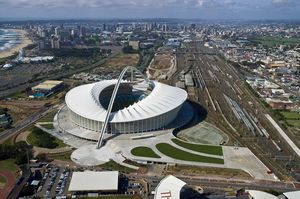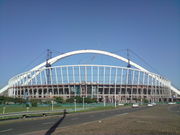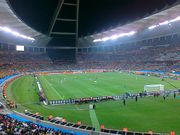Moses Mabhida Stadium
| Moses Mabhida Stadium | |
|---|---|
 |
|
| Location | Stamford Hill, Durban, South Africa |
| Broke ground | 2006 |
| Opened | 28 November 2009 |
| Renovated | 2009 |
| Expanded | 2009 |
| Owner | eThekwini (Durban Metropolitan UniCity) |
| Surface | Grass |
| Construction cost | R 3.4 billion (USD $ 450 million) |
| Architect | Gerkan, Marg and Partners Theunissen Jankowitz Durban, Ambro-Afrique Consultants, Osmond Lange Architects & Planners, NSM Designs, Mthulisi Msimang |
| Capacity | 62,760 FIFA World Cup[1] 54,000 afterwards |
| Field dimensions | Stadium: 320m x 280m x 45m, Arches: 100m |
| Tenants | |
| AmaZulu [1] | |
The Moses Mabhida Stadium is a stadium in Durban, South Africa, named after Moses Mabhida, a former General Secretary of the South African Communist Party. It is intended to be a world-class multi-use stadium.
It was one of the host stadiums for the 2010 FIFA World Cup. The stadium has a capacity of 62,760[1] during the World Cup and 72,000 afterwards. The stadium is adjacent to the Kings Park Stadium, in the Kings Park Sporting Precinct, and the Durban street circuit used for the A1GP World Cup of Motorsport.
It includes an adjoining indoor arena, football museum, sports institute, and a transmodal transport station.
Contents |
Stadium specifics

This newly built stadium is located on the grounds of the Kings Park Soccer Stadium, in the Durban sports precinct in the suburb of Stamford Hill. The stadium had the capacity to hold 62,760[1] spectators during the 2010 FIFA World Cup. Its design allows the stadium seating to be adjusted; 54,000 for local matches or up to 80,000 for events such as the Olympic Games. It has two permanent tiers of seating, a temporary third one has been added for the World Cup.
There are 150 corporate hospitality suites with 7,500 seats.
Dimensions
Stadium: 320m x 280m x 45m
Arch
Somewhat reminiscent of the famous Wembley Stadium arch, a 350-metre (1,148 ft) long free and 105-metre (344 ft) high span arch holds up the roof of the stadium, the top of the arch rises to 106 metres (348 ft) above the pitch. The arch also represents the once divided nation coming together, inspired by the South African Flag.[2] The arch consists of a 5 x 5m steel hollow box and weighs 2,600 tonnes. A funicular carries visitors from the north side of the stadium to a viewing platform at the top of the arch, offering a view over city and ocean. The south side features a 550-step adventure walk.[3] On 24 February 2010 the world's largest swing opened at the stadium. The swing allows clients to jump off the 4th ladder rung and fall toward the pitch before being swung out in a 220-metre (720 ft) arc over the pitch.
Roof
Moses Mabhida Stadium roof consists of a 46,000 m2 (500,000 sq ft), Teflon-coated, glass-fibre membrane which will produce a translucent glow when the stadium is lit. These are attached to the arch by 95mm diameter steel cables. The roof covers 88% of the seats.
Bowl
Around the perimeter, 1,750 columns and 216 raking beams provides the main support. Around the field, 900m of retaining walls stretches 8m high. A total of 1,780 pre-cast concrete seating panels creates the bowl form. There will be over 80,000 square metres (860,000 sq ft) of floor space within the stadium structure..
Facade
Over 100 columns surround the stadium. The height of the columns varies around the stadium, but the highest is 46m. In total 15,000 square metres (160,000 sq ft) of façade will surround the stadium. A total of 550 aluminum fins will fit between the main columns. Perforated metal sheeting will be placed between the aluminum fins, where required.
Construction progress

| Date | Phase | Description | Status |
|---|---|---|---|
| 2006-07-08 | 1 | Destruction of existing stadium, southern pavilion. | Completed |
| 2006-07-12 | 2 | Destruction of existing stadium, northern pavilion. | Completed |
| 2006-07-23 | 3 | Destruction of existing stadium, main pavilion. | Completed |
| 2007-04-01 | 4 | Construction begins. | Completed |
| 2008-03-20 | 5 | Arch construction begins. | Completed |
| 2009-01-13 | 5 | Arch construction complete. | Completed |
| 2009-01-01 | 6 | Aluminum façade construction begins. | Completed |
| 2009-08-01 | 7 | Roof cable and membrane works begins. | Completed |
| 2009-11-24 | Official completion. | Completed |
Completion
Construction of the stadium was officially completed on 24 November 2009 [4] and the first official match played there was between Amazulu and Maritzburg United on 29 November, with Maritzburg United winning 1–0 [5].
2010 FIFA World Cup
The stadium was one of the venues for the 2010 FIFA World Cup and hosted five group games, one second round game and a semi-final match [6]. During the World Cup, the stadium was referred to as 'Durban Stadium'.
2010 World Cup Schedule
| Date | Time (UTC+2) | Team #1 | Res. | Team #2 | Round | Attendance |
|---|---|---|---|---|---|---|
| 2010-06-13 | 20:30 | 4–0 | Group D | 62,660 | ||
| 2010-06-16 | 16:00 | 0–1 | Group H | 62,453 | ||
| 2010-06-19 | 13:30 | 1–0 | Group E | 62,010 | ||
| 2010-06-22 | 20:30 | 2–2 | Group B | 61,874 | ||
| 2010-06-25 | 16:00 | 0–0 | Group G | 62,712 | ||
| 2010-06-28 | 16:00 | 2–1 | Round of 16 | 61,962 | ||
| 2010-07-07 | 20:30 | 0–1 | Semi-final | 60,960 |
See also
- List of stadiums in South Africa
- Kings Park Soccer Stadium
- Kings Park Stadium
References
- ↑ 1.0 1.1 1.2 FIFA.com – Durban Stadium
- ↑ FIFA (2010). "Durban Stadium – Durban". http://www.fifa.com/worldcup/destination/stadiums/stadium=5018127/index.htm.
- ↑ "Moses Mabhida Stadium". http://www.durban.gov.za/durban/discover/2010/moses/. Retrieved 18 June 2010.
- ↑ A defining moment for Durban
- ↑ Maritzburg win with ten men
- ↑ "2010 Fifa World Cup SA Fixtures". Supersport.com. http://www.supersport.com/football/fixtures.aspx?id=275&db=1&y=2010&m=7. Retrieved 2010-05-18.
External links
- City World Cup Site
- Stadium tours
- Stadium website
- http://www.bigrush.co.za
- 360 View
- 360 View from the top
- 360 degree Virtual Tour (6 locations)
- Kirigami model of Durban stadium
|
|||||